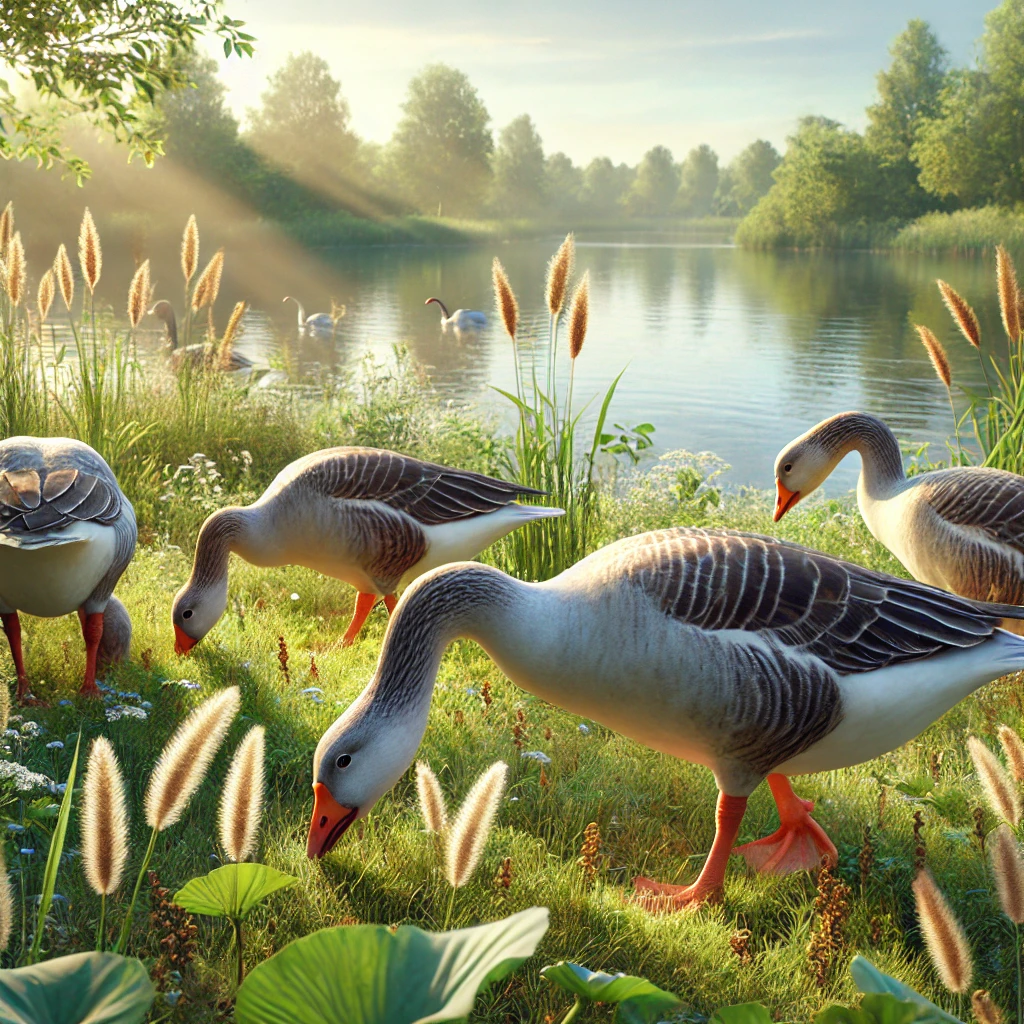What Do Geese Eat?
Geese are familiar sights across parks, lakes, and open fields in Canada, with their distinct honking calls and graceful formations. Their diet plays a significant role in how they thrive in different environments and impacts their behavior, migration, and ecological role. In this blog, we explore what geese eat, how their diet varies by season and location, and why their feeding habits matter to local ecosystems.
1. The Basic Diet of Geese: Herbivorous Grazers with Seasonal Variety
Geese are primarily herbivores, feeding on a range of plant materials. They graze on grasses, seeds, and aquatic plants, although they may sometimes eat small insects or fish when available. Their diet can vary by location and season, allowing them to adapt to changing environments.
- Grasses and Leaves: Geese commonly graze on grasses, especially in spring and summer. Their strong beaks are well-suited for nibbling grass blades and foraging on leaves in open fields.
- Seeds and Grains: During fall and winter, geese rely on seeds, grains, and other plant-based foods. They often forage in agricultural fields for corn, wheat, barley, and other grains left after harvest.
- Aquatic Plants: Geese that inhabit wetlands or lakes consume aquatic plants, algae, and even small amounts of submerged vegetation. These foods provide essential nutrients, especially for migrating geese preparing for long flights.
- Small Insects and Fish (Occasionally): Although rare, geese may consume small insects, fish, or other animal matter if they find it while foraging. However, plant material remains their primary source of nutrition.
2. Seasonal Diet Variations
The diet of geese changes with the seasons as they adapt to available food sources and prepare for migration. Here’s how their diet shifts throughout the year:
- Spring and Summer: Geese mainly consume fresh grasses, young leaves, and clovers, which are abundant and easy to digest. This high-nutrient diet supports growth and energy during the breeding season.
- Fall: As grasses become less available, geese turn to seeds, berries, and grains. They often forage in farmlands, taking advantage of crop leftovers to build fat reserves for migration.
- Winter: In regions with mild winters, geese continue to forage on grains and seeds. In colder areas, geese may migrate to find food sources or switch to eating stored grains in wetlands or marshes.
These dietary shifts help geese survive through seasonal changes and ensure they maintain energy levels for migration and breeding.
3. Feeding Techniques and Foraging Behavior
Geese have unique feeding techniques that allow them to consume a wide range of plant material. They primarily forage by grazing on grasses and may even dig into soil for roots and tubers.
- Grazing: Geese are skilled grazers, using their strong beaks to pull grass, leaves, and other vegetation from the ground. Their social nature means they often graze in groups, which can cover large areas and help them stay alert to predators.
- Dabbling: When foraging in shallow water, geese use a method called “dabbling,” where they tip forward to reach underwater plants and algae. This technique allows them to feed on aquatic vegetation without fully submerging.
- Crop Feeding: In agricultural areas, geese often flock to fields to feed on leftover crops. This behavior can lead to conflicts with farmers, as large flocks may damage crops or deplete resources intended for livestock.
4. Diet of Different Goose Species
While most geese share a similar plant-based diet, there are some differences among species:
- Canada Geese: Canada geese have a flexible diet that includes grasses, seeds, aquatic plants, and agricultural grains. Their adaptability allows them to thrive in urban and rural areas alike.
- Snow Geese: Snow geese rely heavily on roots, bulbs, and grasses. In their breeding grounds, they forage on plants in tundra regions, while they consume grains in agricultural fields during migration.
- Greylag Geese: Greylag geese, native to Europe but also found in Canada, eat grasses, seeds, and aquatic plants. They are often seen grazing on grasses near wetlands and meadows.
Each species has slightly different preferences, but all depend primarily on plant materials to meet their nutritional needs.
5. Nutritional Needs and Health of Geese
The diet of geese provides essential nutrients that support their health, especially during migration and breeding. Plant-based foods like grasses and grains offer high fiber and moderate protein, which geese need to maintain their energy levels. Here’s how their diet supports different aspects of their health:
- Energy for Migration: Migrating geese build fat reserves by consuming high-energy foods like grains and seeds. These reserves provide the necessary fuel for long-distance flights.
- Nutrient-Rich Diet for Growth: Young goslings rely on nutrient-dense grasses and leaves for rapid growth during their first few weeks. This diet allows them to develop strong bones and flight muscles.
- Immune Support: A varied diet with a mix of aquatic plants, seeds, and fresh vegetation supports geese’s immune systems, keeping them healthy as they encounter different environments.
6. Ecological Impact of Geese’s Feeding Habits
Geese contribute to their ecosystems by dispersing seeds and managing vegetation. Their grazing can help control plant growth, especially in areas prone to overgrowth. However, large populations can lead to challenges, particularly in urban areas or farmland:
- Seed Dispersal: Geese often spread seeds through their droppings, supporting plant diversity in wetlands, meadows, and farmlands. This natural seed dispersal helps maintain balanced ecosystems.
- Vegetation Management: By grazing on grasses and aquatic plants, geese prevent overgrowth in certain habitats. This grazing benefits other animals by creating open spaces and reducing competition for resources.
- Challenges in Urban and Agricultural Areas: In urban parks or agricultural fields, large flocks of geese may consume substantial amounts of vegetation or crops. This can lead to damage or create challenges for local landowners who rely on these resources.
7. Human Interaction and Conservation of Geese
People interact with geese frequently, especially in urban areas where they often graze in parks and fields. While their feeding habits benefit the ecosystem, managing geese populations in certain areas can help reduce negative impacts. Conservation efforts focus on maintaining balanced habitats to support geese while minimizing conflicts with humans.
Frequently Asked Questions About Geese’s Diet
- Do geese eat bread?
While geese may eat bread offered by humans, it’s not suitable for their health. Bread lacks the nutrients they need and can lead to malnutrition. - Can geese eat grass year-round?
Yes, geese can graze on grass whenever it’s available. However, in colder months, they may switch to seeds, grains, and other plant material as grass becomes scarce. - Do geese eat fish or meat?
Geese are primarily herbivores, so they do not rely on fish or meat. They may occasionally eat small insects or fish, but this is rare and not essential to their diet.
Conclusion
Geese thrive on a plant-based diet, consuming grasses, seeds, aquatic plants, and grains to meet their nutritional needs. Their diet shifts seasonally to adapt to available food sources, supporting their energy requirements for migration and breeding. As natural grazers and seed dispersers, geese play an important role in ecosystems, although their feeding habits can pose challenges in human-populated areas. By understanding what geese eat, we gain insight into their behavior, health, and ecological impact, appreciating these adaptable birds and their role in nature.






